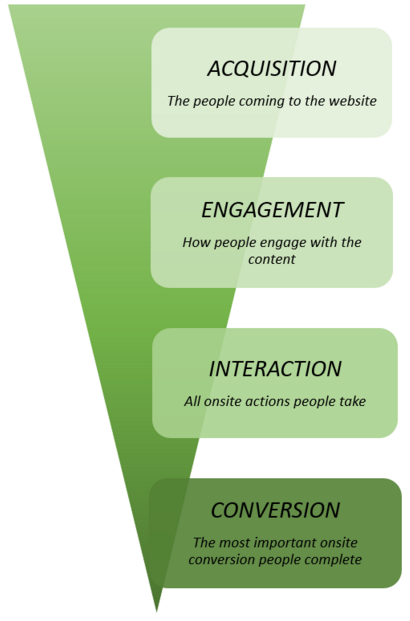Struggling to get more value from your online marketing? Time to shape up or ship some tactics out?
If so, let me offer the humble funnel as a tool to steer your turnaround, help you apply the right tactics in the right order, and ensure a steady passage towards your goals.
There’s real power and magic in the funnel. Its basic premise is that more people arrive on your website than decide to convert. So it makes sense that the top is wider than the bottom :).
The segments below the top describe the different levels of engagement as people meander through your pages. There will always be those who bounce in and, before you know it, have bounced out again. Whoa – the funnel just got a bit smaller!
Now we’ve got those who have remained and are enthralled with your content. They’re hanging around to play the videos you’ve so cleverly provided, or download PDFs.
Now you’ve got a funnel that look something like this.

Like all models, it doesn’t capture every situation – and that sharp point may be a bit too sharp. But this little shape with just its four stages can really help you focus on the right things when turning around your online marketing.
Let’s consider two scenarios – one great, one not so great.
The great one first. Here I am, one of your prospects. I hop across to Google to start a search. Bang! and there you go – Google worked. Just what I wanted is staring me squarely in the face.
So I click and arrive on a website that looks just as I hoped. The content is good – it keeps me lingering longer than I planned. Then – not wanting to waste all that invested time – I’ve made contact so someone can follow up with me later.
I’m happy. And, as the website owner, so are you!
Now for the not so great scenario.
Now let’s look at how the four stage funnel can help us debug a poor performing website which delivers very few of these scenarios. First up let’s deal with the top part of our friendly funnel – Acquisition.
I’m the same prospect as before, but this time when I do my Google search, I don’t see your website anywhere. Poor SEO and ineffective AdWords advertising are the problems you need to address first. Until you do, the rest of the funnel is irrelevant. It’s empty.
So now you’ve sorted that issue and I find your site. But I don’t stay long. In that case, the content of your website now needs serious work. Very rarely do we see a website with poor engagement perform well in Interaction and Conversion.
So now you’ve sorted your content and your interaction levels have shot through the roof. But conversions suck. Usually that’s a result of not having the kind of interactive content that the customer needs to make the purchase decision. For instance, complex products or services may require videos to explain them, or PDF documents to provide more detail.
Employing the funnel theory can help you focus your efforts on fixing the right things. For instance, it can help you avoid wasting money on a five minute video of your services (an interaction event) until you’ve increased your engagement values (time on site and pages per session) sufficiently to ensure visitors are spending enough time to even find or play the video.
Or you may decide not to purchase additional advertising from Google until you’ve done something about your 70% bounce rate (again those engagement values need work!).. And yes, improving these stats can be a lot harder and possibly a lot less fun than creating a video or buying more clicks from Google. Sorry … I never said using such a simple shape could make the work simple too.
Nevertheless, when there are more tactics available online than there is time to deliver, the funnel should help you focus on fixing the right parts first. Contact us today to arrange a session with a member of our team on how your online marketing performs against best practice for each of these four stages.
